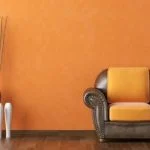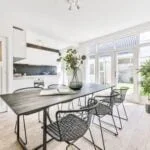Display homes are meticulously designed spaces that serve as showcases for potential home buyers, offering a glimpse into the lifestyle that a particular property can offer. But have you ever wondered who decorates display homes to make them so appealing? Interior designers play a crucial role in transforming these empty spaces into warm, inviting environments that resonate with buyers. Their expertise in color schemes, furniture arrangement, and overall aesthetics can make all the difference in attracting prospective homeowners.
The concept of display homes is not just about showcasing the physical aspects of a property; it’s also about creating an emotional connection with potential buyers. Interior designers bring their creative vision to life by carefully curating every detail, from the choice of artwork to the placement of decorative accents.
The process involves a collaborative effort between designers, home builders, and real estate agents to ensure that each display home tells a unique story and speaks to its target audience.
In this article, we will delve into the creative process involved in decorating display homes, exploring everything from initial concept development to final execution. We will also discuss current trends in display home decoration, such as minimalist or modern farmhouse styles, and highlight the importance of staging in creating a cohesive and attractive look. By understanding the intricacies of display home decoration, readers can gain valuable insights for decorating their own spaces and enhancing their homes’ appeal on the market.
The Role of Interior Designers
Display homes serve as a crucial marketing tool for real estate developers, showcasing the potential of a property to prospective buyers. One essential aspect of these display homes is the interior design, which plays a significant role in attracting and captivating potential buyers. Interior designers are the creative minds behind the decoration of these display homes, carefully crafting spaces that are not only visually appealing but also functional and inviting.
Interior designers who decorate display homes understand the importance of creating spaces that resonate with the target audience. They take into account current design trends, buyer demographics, and the overall aesthetic of the property when conceptualizing their designs. By incorporating elements like color palettes, furniture arrangements, and decorative accents, interior designers create cohesive and aspirational spaces that inspire buyers to envision themselves living in the home.
The creative process involved in decorating display homes is multi-faceted, starting from initial concept development to final execution. Interior designers collaborate with home builders and developers to understand the vision for the property and tailor their designs accordingly.
They select furniture, accessories, lighting fixtures, and artwork that complement the architectural style of the home while creating a sense of luxury and comfort. The goal is to create a space that feels both sophisticated and livable, enticing potential buyers to imagine themselves living in the home.
Creative Process
Initial Concept and Inspiration
When it comes to decorating display homes, the creative process begins with the development of an initial concept. Interior designers who decorate display homes often draw inspiration from various sources such as magazines, design blogs, social media platforms, and even nature. These sources help in creating a vision for the overall look and feel of the space, taking into consideration factors like the target demographic, market trends, and the specific style preferences that will resonate with potential buyers.
Mood Boards and Color Schemes
Once the initial concept is established, interior designers move on to creating mood boards that visually represent the chosen theme or design direction for the display home. Mood boards serve as a guide for selecting color schemes, furniture pieces, accessories, and decor elements that will be used in the space.
Carefully curated color palettes play a significant role in setting the tone for each room within the display home, whether it’s creating a calming oasis in a bedroom or an inviting social area in a living room.
Execution and Installation
The final stage of the creative process involves bringing the vision to life through execution and installation. Interior designers work closely with their team of stylists, carpenters, painters, and other professionals to transform an empty shell into a stunning showcase of design excellence.
From placing furniture in strategic positions to hanging artwork on walls with precision, every detail is meticulously planned out to ensure that the display home resonates with potential buyers on an emotional level. The cohesive blend of aesthetics and functionality is key to creating spaces that inspire visitors and make them envision themselves living there.
Trends in Display Home Decoration
In the ever-evolving world of interior design, display homes serve as a canvas for showcasing the latest trends and styles in home decoration. These spaces are meticulously designed to appeal to potential buyers and showcase the possibilities of a well-decorated home. One of the key questions that arise when exploring display homes is: who decorates these spaces? The answer lies with skilled interior designers who bring these visions to life.
The Role of Interior Designers
Interior designers play a crucial role in shaping the look and feel of display homes. They are responsible for creating cohesive and visually appealing spaces that resonate with potential buyers. By incorporating current trends and styles into the design, interior designers infuse personality and character into each room, creating an immersive experience for visitors. From selecting furniture pieces to choosing color palettes, these professionals carefully curate every element in the space to evoke a sense of luxury and comfort.
Creative Process
The creative process involved in decorating display homes is a multi-faceted journey that begins with an initial concept and culminates in a stunning visual presentation. Interior designers start by conducting thorough research on current trends and client preferences.
They then proceed to develop mood boards, select materials, furniture, accessories, and create layouts that highlight the best features of the home. Throughout this process, creativity plays a vital role as designers experiment with different textures, colors, and styles to create unique and inviting spaces that captivate potential buyers.
The Importance of Staging
Display homes serve as the perfect canvas for potential buyers to envision themselves living in a new space. From the layout and design to the smallest decorative details, everything is meticulously planned and executed to create a lasting impression. One of the key elements in making display homes attractive and appealing is staging. Staging involves setting up furniture, decor, and accessories in a way that showcases the full potential of the space and highlights its best features.
Staging plays a crucial role in creating a cohesive look throughout the display home. It helps potential buyers see the functionality of each room, understand the flow of the space, and visualize themselves living there.
Interior designers are often the ones responsible for staging display homes, as they have the expertise to select furniture pieces, arrange them in an appealing way, and add finishing touches that bring warmth and character to the space. They work closely with home builders to ensure that every detail aligns with the overall design concept and target market.
| Staging Benefits | Description |
|---|---|
| Highlights Potential | Staging showcases how each room can be utilized effectively. |
| Creates Emotional Appeal | Staging evokes positive emotions that encourage buyers to make an offer. |
| Showcases Lifestyle | Staging helps paint a picture of a desirable lifestyle associated with the property. |
Collaborations With Home Builders
In the world of display homes, the collaboration between interior designers and home builders plays a critical role in creating visually stunning and appealing spaces that attract potential buyers. Interior designers are the creative minds behind the decoration of display homes, working closely with home builders to ensure that each property is expertly staged and designed to showcase its full potential.
These collaborations bring together the expertise of both parties to create a cohesive and attractive look that highlights the best features of the home.
The collaboration between interior designers and home builders begins with a thorough understanding of the property’s target market and desired aesthetic. Interior designers work closely with home builders to develop design concepts that align with the overall vision for the display home.
This collaborative process often involves brainstorming sessions, mood boards, and site visits to ensure that every detail is meticulously planned out before execution begins. By working together, interior designers and home builders can leverage their respective skills to transform an empty space into a captivating showcase for potential buyers.
One of the key benefits of collaborating with home builders in decorating display homes is the seamless integration of design elements within the overall construction process. By involving interior designers from the early stages of development, home builders can optimize layouts, finishes, and architectural details to better complement the final design scheme.
This level of collaboration ensures that every aspect of the display home is thoughtfully curated and coordinated, enhancing its overall appeal to potential buyers looking for their dream home.
| Collaboration Benefits | Details |
|---|---|
| Seamless Integration | Involving interior designers from early stages |
| Enhanced Appeal | Careful curation and coordination for buyer attraction |
Success Stories
Successful display homes play a pivotal role in the real estate industry, capturing the attention of potential buyers and showcasing the best features of a property. These homes are meticulously decorated to appeal to a wide range of tastes and preferences, ultimately influencing the decision-making process of buyers. Let’s delve into some success stories of display homes that have made a lasting impact on potential buyers.
Key Success Stories
- Incorporating Smart Technology: Display homes that integrate smart technology solutions, such as automated lighting or security systems, have seen a significant increase in interest from tech-savvy buyers. The convenience and modernity offered by these features can set a property apart from others in the market.
- Creating Lifestyle Scenes: Some display homes are designed to evoke specific lifestyle scenes, such as a cozy family room or an elegant outdoor entertaining area. By showcasing these lifestyle settings, potential buyers can envision themselves living in the space and create an emotional connection with the property.
- Embracing Sustainable Design: With an increasing focus on sustainability and eco-conscious living, display homes that incorporate sustainable design elements like energy-efficient appliances or recycled materials have resonated well with environmentally conscious buyers. These homes demonstrate a commitment to green living while still maintaining style and functionality.
The Impact of Decoration
The decoration of display homes has a direct impact on how potential buyers perceive a property. From the color scheme to the furniture layout, every detail is carefully considered to create a welcoming and aspirational environment. Successful display homes not only attract buyers but also inspire them to visualize themselves living in the space, ultimately leading to quicker sales and higher property values.
Tips for Decorating Your Own Home
Display homes are the epitome of interior design excellence, showcasing the perfect balance of style, comfort, and functionality to attract potential buyers. For those wondering who decorates display homes, interior designers play a pivotal role in bringing these spaces to life. They possess the expertise and creativity needed to transform a blank canvas into a captivating vision that speaks to potential homebuyers on an emotional level.
When it comes to decorating your own home, drawing inspiration from the expertly curated display homes can be a game-changer. To help you elevate your own living space, here are some tips and tricks inspired by the decoration of display homes:
- Start with a neutral base: Like many display homes, opt for a neutral color palette as the foundation of your décor. This creates a timeless backdrop that allows you to easily switch up accent pieces and accessories.
- Focus on statement pieces: Invest in key furniture and décor items that make a statement in your home. Whether it’s a bold piece of artwork or a striking piece of furniture, these elements can truly elevate the look of any room.
- Bring in natural elements: Just like in display homes, incorporating natural elements such as wooden accents, indoor plants, or natural fibers can add warmth and texture to your space. It also helps create a sense of harmony with the outdoors.
By implementing these tips inspired by the decoration of display homes, you can infuse your own living space with style and sophistication that will impress guests and create a sanctuary for yourself. Remember, professional interior design is not just reserved for showrooms – it can enhance the overall look and feel of your home as well.
Conclusion
In conclusion, display homes play a crucial role in the real estate industry as they serve as a tangible representation of a property’s potential to prospective buyers. Interior designers are the creative minds behind the captivating decorations seen in these showcase homes, utilizing their expertise to attract and engage potential buyers. The collaboration between interior designers and home builders is essential in creating a cohesive and visually appealing display that showcases the full potential of a property.
The creative process involved in decorating display homes is both intricate and detailed, starting from the initial concept stage all the way to the final execution. Current trends in display home decoration, such as minimalist, Scandinavian, or modern farmhouse styles, continuously evolve to cater to the changing preferences of homebuyers. Staging plays a vital role in enhancing the overall appeal of display homes, setting the stage for potential buyers to envision themselves living in the space.
Successful display homes serve as prime examples of how professional decoration can significantly impact the selling process by capturing the imagination and desires of potential buyers. By implementing tips and tricks inspired by these showcase homes, individuals can transform their own living spaces into inviting and aesthetically pleasing environments. Ultimately, investing in professional decoration not only enhances the visual appeal of a home but also increases its market value and expedites its sale effectively.
Frequently Asked Questions
What Do You Call a Person Who Decorates Houses?
A person who decorates houses is typically referred to as an interior decorator. This individual specializes in selecting color schemes, furniture, decor, and other elements to enhance the aesthetic appeal of residential spaces.
What Is the Professional Name for a Home Decorator?
The professional name for a home decorator is an interior designer. Interior designers not only focus on the aesthetics of a space but also take into account its functionality and practicality. They often work closely with clients to create personalized and functional living environments.
What Is the Difference Between a Designer and a Decorator?
The main difference between a designer and a decorator lies in their scope of work and expertise. While decorators primarily focus on aesthetics and decor choices, designers have a broader skill set that includes spatial planning, architectural knowledge, and understanding of building codes.
Designers are often involved in the structural aspects of space design, such as layout, flow, and lighting design.

I’m thrilled to be your companion on this exciting journey through the world of home decor and design. With a passion for turning houses into homes and a keen eye for the finer details, I’m here to help you transform your living spaces into beautiful, functional, and meaningful havens.





